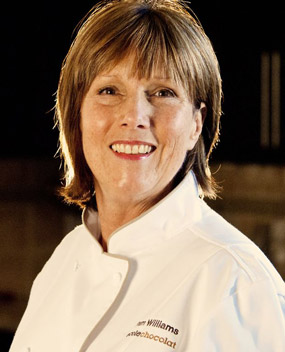
By Pam Williams
For me, there is nothing tastier than a bit of fine chocolate during a morning coffee break. Chocolate in the morning? Try it some time. But before you scarf down that tasty morsel, let me tell you something about where it came from and how precious and endangered it is.
Chocolate and its flavor begins with the work of farmers, not factories. All chocolate is made from cocoa beans -- seeds from the fruit of the cacao tree, a species that flourishes only in areas 20 degrees north or south of the equator. Ninety-percent of cacao trees in this 20-20 zone in the developing world are grown on small family farms. Less than 5% of that crop is considered "fine flavor" by the industry -- cacao destined for artisanal chocolatiers and fine chocolate manufacturers -- and it's sourced in such countries as Peru, Venezuela, Brazil, Sri Lanka and Madagascar, among others.
Think about chocolate as you would about wine. Like grapes, the flavor of cacao is determined by genetics and terroir. How the cacao is dried after picking, how it is fermented on the farm and processed by the manufacturer all contribute to its flavor profile. A fine flavor cacao bean, like a Cabernet Sauvignon grape, will produce different flavor depending on the year it is grown and harvested.
At the turn of the 20th century, the vast majority of the world's cacao trees were what we consider today to be fine flavor. Our assumption is that in the 18th and 19th centuries, only the trees with the best-tasting cacao, native to Mesoamerica, were propagated in colonies all around the equator. But over time, the demand for cheaper beans and mass-produced chocolate increased, prompting a search for trees with higher yields and better disease resistance -- flavor quality was sidelined in the interests of quantity. Traditional fine flavor cacao orchards and farms were rapidly replaced.
Even those beans destined for bulk or ordinary flavor chocolate are difficult to farm. Cacao trees are extremely labor intensive and difficult to raise. Compared to soy or bananas, crops that flourish in the 20-20 zone, cacao trees are significantly less prolific or profitable. The farmer must go through seven processes, each one of them time- and labor-consuming, to get the beans to market. When the cacao pod ripens, they must be individually harvested by hand. The pods are cracked open and their beans are then carefully removed. The beans then ferment in a box or pile for anywhere from two to eight days, after which they're dried to a specific humidity level, sorted and bagged.
Few crops require even half the number of steps to get from field to market. Bananas, for example, which are handled in bunches rather than individually, need only be bagged (to deter pests), harvested and washed. It can be extremely tough to make money growing cacao trees, even with the increasing demand for cheaper chocolate.
Cheap chocolate should be an oxymoron -- consumers don't recognize the labor and expense behind it. That must change. Chocolate is in essence a luxury purchase; we don't need it. For now, when we crave a piece of it, we can choose between a bonbon made by a passionate artisan and a candy bar from the corner store. While eating chocolate is an indulgence for us as consumers, for the cacao farmer our appetite for chocolate is a matter of survival. Given the present price structure, fine-flavor cacao producers may not be able to survive.
Ironically, as the demand for great-tasting chocolate increases across the globe, fine flavor cacao is in danger. Most farmers aren't paid a premium for better beans, and the return on their investment may not, in the future, be enough. Traditional farms are already being replaced by high-yield hybrids with one-note flavor. For farmers in the 20-20 zone, it makes less and less sense to struggle with the more delicate fine-flavor cacao trees.
So if you want to continue to have the option to purchase fine chocolate, to enjoy the complex and subtle notes that are a result of painstaking farming and processing, vote with your wallet. By paying a little more for artisanal and other high-end chocolates, you'll be helping to sustain the fine flavor cacao industry.
Pam Williams has been in the chocolate industry since 1981 and founded Ecole Chocolat Professional School of Chocolate Arts in 2003. She has been instrumental in promoting the Heirloom Cacao Preservation Initiative (HCP), a partnership between the Fine Chocolate Industry Association and the USDA's Agricultural Research Service to create the first genotype map with a focus on flavor cacao trees.
Top photo: Pam Williams. Credit: Robert Ouimet
Also on Zester Daily, Thanksgiving tips: